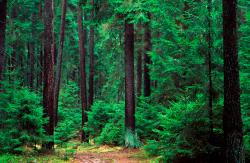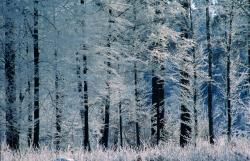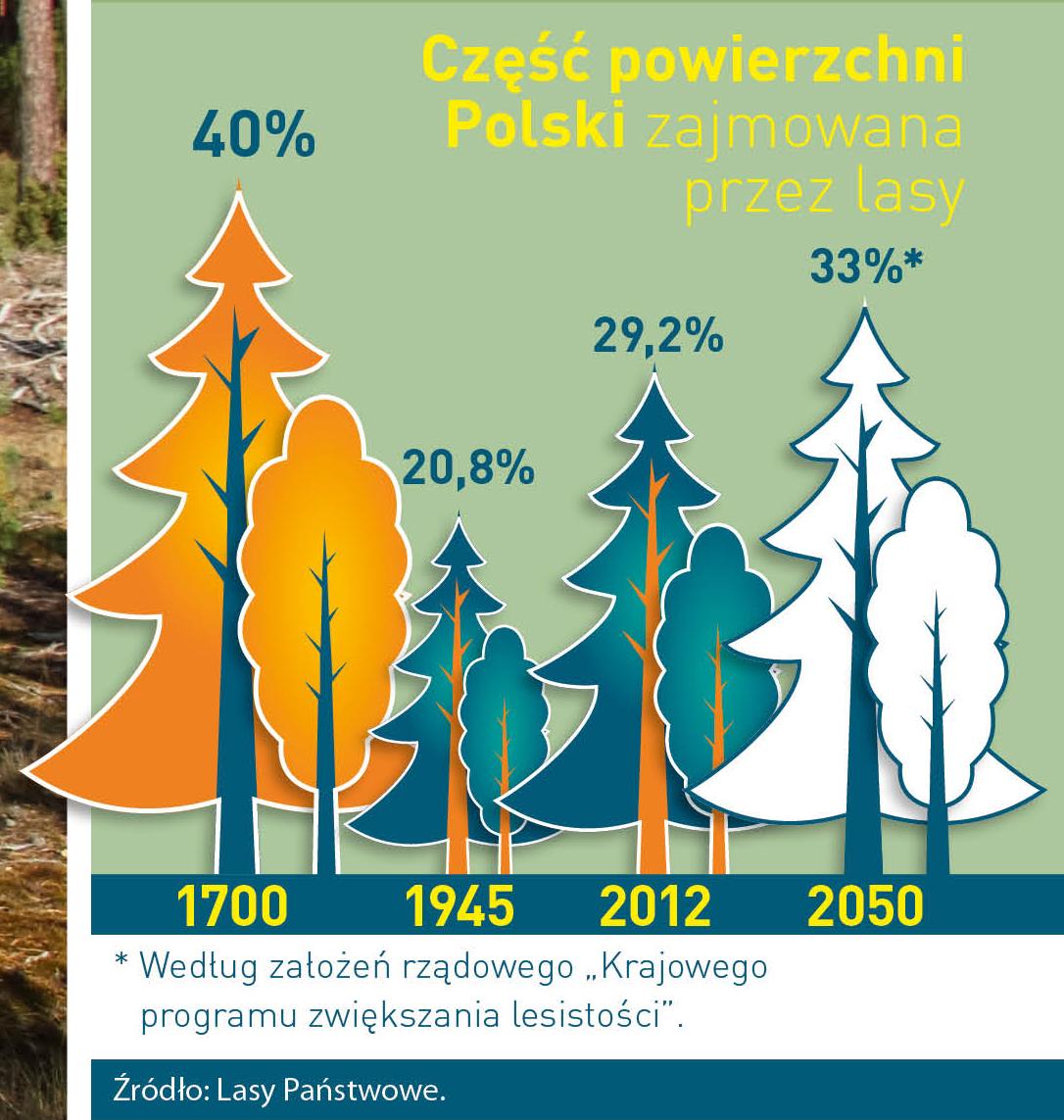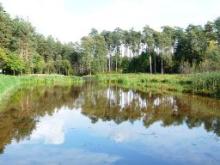 Asset Publisher
Asset Publisher
Polish forests
Poland is in the European lead, while concerning the area of all forests. They cover about 29,2 % of the country territory, and grow within the area of 9,1 million hectares. The overwhelming majority of the forests is state owned, of which almost 7,6 million hectares are managed by the State Forests National Forest Holding..
The number of Polish forest is still growing. The forestation rate of the country has increased from 21 % in 1945 to 29,2 % at the moment. Between 1995 and 2008, the forest area increased by 310 thousand ha. The basis for afforestation works is the "National Programme for Increasing the Forest Cover" (KPZL), assuming an increase of the forestation rate up to 30 % by 2020 and up to 33 % by 2050. Polish forests abound in flora, fauna and fungi. 65 % of the total number of animal species live there.
The forests grow in our country on poor soils, mainly because of the development of the agriculture in previous years. It influences the distribution of the types of the forest sites in Poland. Over 55 % of the forest areas is covered with coniferous forests. In other areas, there are forest sites, mainly the mixed ones. Their small part constitute alder and riparian forests – not more than 3 %.
In the years 1945 – 2011 the area of natural deciduous tree stands within the area of the State Forests National Forest Holding increased from 13 to 28,2 %.
Within the lowlands and uplands the most often occurring tee species is pine. It covers 64,3 % of the forest area of the State Forests National Forest Holding and 57,7 % of private and commune forests. In the mountains the predominant species is European spruce ( in the west) and European spruce with beech (in the east). Domination of pine is the result of carrying on sustainable forest management in the past. Once, the monocultures (crops or cultivations of one species) were the answer to the great demand of industry for wood. Such forests appeared to be quite fragile to climatic factors. They also were often the prey of pests' expansion.
In Polish forests, the share of other tree species, especially deciduous trees have been systematically increasing. The foresters have stepped aside from monocultures – that is why, they try to fit specific species of the forest stand to the natural stand, that would be proper for the given area. Thanks to that, in the years 1945 – 2011, the area of the deciduous tree stands within the lands of the State Forests National Forest Holding increased from 13 to 28,2 %. There occur more and more frequently the following tree species: oaks, ashes, maples, sycamore maples, elms, but also birches, beeches, alders, poplars, hornbeams, aspens, tilias and willows.
Our forests are the most often represented by the forest stands aged 40 to 80 years. The average age of the forest equals 60 years. More and more trees are of big size at the age over 80 years. Since the end of the Second World War, the forests' area has increased up to almost 1,85 million hectares.
Raport o stanie lasów w Polsce 2012
 Asset Publisher
Asset Publisher
Będą opryski ochronne w lasach Nadleśnictwa Leżajsk
Będą opryski ochronne w lasach Nadleśnictwa Leżajsk
Nadleśnictwo Leżajsk informuje, że w dniach 28 - 30 kwietnia przeprowadzony zostanie zabieg ograniczania liczebności chrabąszcza majowego, z zastosowaniem środka chemicznego MOSPILAN 20 SP. Opryski agrolotnicze planowane są na powierzchni 812 ha na polu zabiegowym położonym na terenie leśnictw Kulno, Brzyska Wola i Mołynie na terenie gminy Kuryłówka i Leżajsk. W okresie od 28 kwietnia do 30 kwietnia 2025 roku obowiązuje okresowy zakaz wstępu do lasu.
Stosowany przy opryskach środek chemiczny MOSPILAN 20 SP ma 14-dniowy okres karencji.
Karencja to minimalny okres czasu jaki musi upłynąć od zastosowania środka chemicznego do zbiorów płodów runa leśnego.
Uwaga!!!
Na obszarze objętym zabiegiem agrolotniczym od 28.04.2025 do 14.05.2025 roku (włącznie) obowiązuje 14 - dniowy okres karencji, w którym nie wolno zbierać płodów runa leśnego.
W celu zapoznania się z warunkami stosowania środka oraz szczegółami związanymi ze zwalczaniem imago (postaci dorosłej) chrabąszcza majowego zachęcamy do zapoznania się z etykietą środka MOSPILAN 20 SP.
W okresie wykonywania zabiegów agrolotniczych wprowadzony zostanie okresowy zakaz wstępu do lasu, który obowiązywać będzie od 28 kwietnia do 30 kwietnia 2025 roku. Obszar objęty zakazem wstępu do lasu zaznaczony jest na mapie w załączeniu oraz oznaczony na mapie BDL. https://zakazywstepu.bdl.lasy.gov.pl/zakazy/
O zakazie zostały również poinformowane gminy i pszczelarze. Przed wykonaniem zabiegu na wejściach do lasu ustawione zostaną stosowne tablice informacyjne.
Przedmiotem zabiegu agrolotniczego będzie chrabąszcze: majowy i kasztanowiec, groźne szkodniki drzewostanów i upraw leśnych, a także rolniczych i sadowniczych. Najpoważniejsze szkody wyrządzają larwy chrabąszczy - pędraki, które obgryzając korzenie sadzonek zagrażają trwałości upraw.
WAŻNE!!
Nadleśnictwo Leżajsk informuje, że na podstawie doświadczeń terenowych, chrabąszcze z pól zabiegowych objętych zabiegiem chemicznym, mogą przemieszczać się na odległość nawet do kilku kilometrów od obszaru, na którym wykonano oprysk agrolotniczy. Z związku z tym, w okresie wykonywania zabiegów agrolotniczych, stwierdzenie obecności martwych chrabąszczy na obszarze poza polami zabiegowymi jest zjawiskiem powszechnym i nie wskazuje na wykonanie zabiegu chemicznego poza obszarem do tego celu wyznaczonym.
Zabieg polega na wykonywaniu oprysków lotniczych i naziemnych nieszkodliwym dla pszczół preparatem Mospilan 20 SP. Preparat Mospilan 20 SP stosowany jest w małych dawkach – 0,4 kg na ha, mała jest też ilość cieczy użytkowej – łącznie z adiuwantem zwiększającym lepkość, zużywa się 5 litrów cieczy użytkowej na 1 ha. Preparat na danej powierzchni może zostać użyty tylko 1 raz w roku. Samoloty, za pomocą których wykonuje się opryski na polach zabiegowych, są naprowadzane przy użyciu precyzyjnej aparatury GPS.
Tekst: Nadleśnictwo Leżajsk


 fot. Paweł Fabijański
fot. Paweł Fabijański
 fot. Paweł Fabijański
fot. Paweł Fabijański
 fot. Paweł Fabijański
fot. Paweł Fabijański


